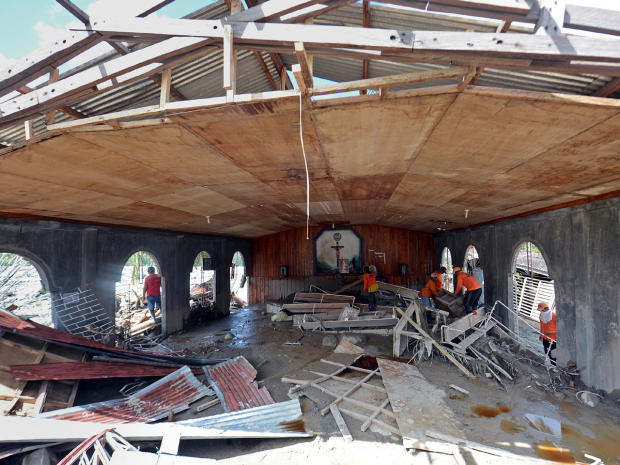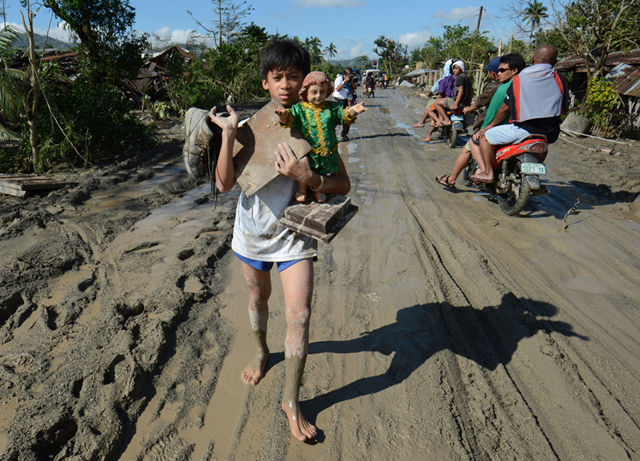Hundreds of fishermen missing after Philippine typhoon – Philippines climate negotiator appeals for action at Doha
By Bullit Marquez
9 December 2012 NEW BATAAN, Philippines (AP) – The number of people missing after a typhoon devastated parts of the southern Philippines jumped to nearly 900 after families and fishing companies reported losing contact with more than 300 fishermen at sea, officials said Sunday. The fishermen from southern General Santos city and nearby Sarangani province left a few days before Typhoon Bopha hit the main southern island of Mindanao on Tuesday, triggering flash floods that killed more than 600, Civil Defense chief Benito Ramos said. Ramos said the fishermen were headed to the Spratly Islands in the South China Sea and to the Pacific Ocean. He said there has been no contact from them for a week. “We have declared them missing,” he said. “Maybe they are still alive.” Ramos said they may have sought shelter on the many small islands in the Spratlys and the Celebes Sea, and lost battery power and have not been able to call. He said the coast guard, navy and fishing vessels have launched a search.
After slamming into the southern Philippines, the typhoon moved out to sea but then veered back toward the country’s northwest on Saturday, prompting worries of more devastation. As of late Sunday, however, it had begun to dissipate and weaken into a low pressure area as it moved farther into the South China Sea, about 65 miles west of the Philippines’ Ilocos Norte province. Rescuers continued searching for bodies or signs of life under tons of fallen trees and boulders in the worst-hit town of New Bataan, where rocks, mud and other rubble destroyed landmarks, making it doubly difficult to search places where houses once stood. Hundreds of refugees, rescuers and aid workers took a break Sunday to watch the Manny Pacquiao-Juan Manuel Marquez fight on a big TV screen, only to be dismayed by their hero’s sixth-round knockout. Elementary school teacher Constancio Olivar said people fell silent when Pacquiao, who comes from the southern Philippines where the storm hit, fell heavily to the canvas and remained motionless for some time. “It was like a double blow for me — this disaster and this defeat,” said Olivar, whose house was destroyed in the storm. “We were all crestfallen. Everyone fell silent, stunned. It was like we saw a tsunami.” Nearly 400,000 people, mostly from Compostela Valley and nearby Davao Oriental province, have lost their homes and are crowded inside evacuation centers or staying with relatives. […]
Hundreds of fishermen missing after Philippine typhoon 
9 December 2012 (The Age) – Hungry survivors of a deadly typhoon in the Philippines have raided shops and warehouses after aid deliveries were delayed. Officials monitored the desperate scenes in the aftermath of typhoon Bopha’s onslaught in the isolated southern town of Cateel, a provincial official, Cedric Daep, said. ”The food aid took so long to arrive that the locals broke into whatever building was left standing in search of something to eat,” said Daep, who was sent to the devastated south by the government to help rescue and relief operations. The typhoon killed more than 500 people and left hundreds missing across the south. About 393,000 people are said to be living in evacuation centres or receiving some other form of government assistance. Warehouses and grocery stores were broken into in Cateel, a coastal town near where the eye of the typhoon made landfall on Tuesday. Officials said damage to roads and bridges by floods and landslides trapped 150,000 people for three days in Cateel and nearby towns Baganga and Boston. They said almost all buildings were flattened or unroofed. A Philippine Navy vessel with 31 tonnes of emergency relief and 132 volunteer aid workers reached Baganga on Thursday, navy spokesman Omar Tonsay said. There are claims climate change, deforestation, poor planning and other factors had worsened the catastrophe. Government officials said this week that storm patterns related to climate change had put communities unaccustomed to strong typhoons in Bopha’s path. But they also said the destruction had been exacerbated by deforestation from illegal logging and small-scale mining, as well as poor planning and confusion created by unclear maps of vulnerable areas. The Environment Secretary, Ramon Paje, said this week about 80 per cent of the illegal logging ”hot spots” in the Philippines are in Compostela Valley, the province that sustained the worst flooding. The denuding of mountains was seen as a factor in the landslides and flooding. Last December, more than 1200 people in the Philippines were killed by typhoon Washi, a powerful out-of-season storm that took an unusual southern track and surprised local officials, exposing thousands to flash floods. The government vowed to crack down on risks – such as illegal settlements in flood-prone areas – to avoid a repeat of the disaster. A year later, Bopha took a similar southern track and sent landslides and flash floods barrelling through small, vulnerable communities where thousands of people remained at the height of the storm. The government, including the President, Benigno Aquino III, had issued repeated strong warnings urging residents to prepare, but some apparently had few options. Officials in New Bataan, in the hardest-hit area, reported some evacuation centres that were supposed to provide refuge had flooded during the storm.
Typhoon survivors plunder food as they await aid 
By Andres Fuentes for theverb The G77 have set their eyes on securing a second commitment period of the Kyoto Protocol at the latest round of climate change meetings in Doha, Qatar this week. Naderev Saño, Commissioner of the Philippine Climate Change Commission and Deputy Head of the Philippine Delegation, talked G77 and Filipino politics exclusively with The Verb. The main priority of the G77 is in securing a second commitment period for the Kyoto Protocol that is high in levels of ambition and free of loopholes. “We have been trying to save the Kyoto Protocol for many, many years and this is our last chance because the first commitment period is ending by the end of December,” stated Mr. Saño. The G77 hopes that their common position on allowing for some carry over of surplus carbon credits may encourage Japan, New Zealand and Russia, countries who have not signed on to the second commitment period, to still allow for progress. The nearing expiration date of the first commitment period will add pressure on negotiators to ensure the continuation of the only legally binding treaty on climate change. The second commitment period is necessary to bridge the gap between the original Kyoto Protocol and Durban Platform for Enhance Action, to be negotiated by 2015. Without this intermediary stage, there is likely to be a crisis of confidence about the ability and effectiveness of the United Nations to solve climate change. The G77 will also be pushing for increased adaptation finance and continued participation from countries such as Canada, who have formally withdrawn from the Kyoto Protocol even if a second commitment period was to be agreed upon in Doha. Saño emphasised that “We cannot contribute towards mitigation if we are not secure with our adaptation actions.” Saño recognised that the G77 inevitably faces challenges with its diversity of 131 members states though. Many members also face domestic capacity challenges, lacking the resources to properly cover the negotiations; something of concern as there will be seven negotiating streams this year. These challenges have already manifested in the form of a joint G77 statement and additional statements that represent the different priorities of each country. It’s this diversity that adds breadth to the G77 whilst simultaneously limits their diplomatic influence. Closer to home Saño discussed the Philippines People’s Survival Fund [pdf]; created this year with an allocated $1 billion pesos, the equivalent to $US25 million to kickstart grassroots adaptation programs. The Philippines clocked in at third in a report ranking vulnerability to climate change. Given that, Saño told The Verb that “We cannot wait for the international process to let funds flow into the Philippines.”
Naderev Saño on Kyoto, the G77 and Philippines

